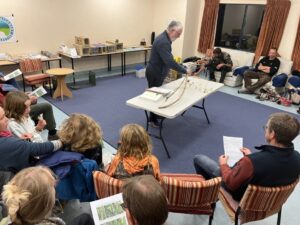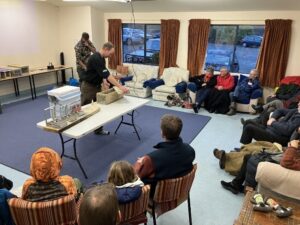Let’s get those pests! MCC event run down
The MCC Pest Management Thematic Group held a trapping and pest weed event on a wet winters day in Ngātīmoti. Around 20 brave attendees weathered the rain on a cold winter’s night to learn about all things trapping and old mans beard related in the catchment. At least the community rooms were warm.
A local resident was delighted to share his observation of a whio whistle, heard downstream of the Pokororo River during a chilly solstice moonlit swim. The increasing presence of these iconic ducks on the awa is testament to the Farmers 4 Whio trapping project, which works to create safe whio habitat in the sub catchments bordering the Kahurangi.
Barry Burger, trapping field officer for the project, explained how the network of nearly 600 traps has helped whio to establish in the fast flowing streams that characterise their preferred habitat. Volunteer trappers enjoy their excursions to check trap lines.
Barry demonstrated the correct and safe setting of a variety of traps, including the standard DOC 150 and DOC 200s, as well as T-Rex rat traps and Trapinator possum traps.
Some resources to help you are available on the MCC website here.
Top tips on where to place traps helped the group understand that you cannot just put out a trap and leave it. Look for a site along fencelines or places where animals might be curious, like compost heaps. Once one critter has visited, this generates interest from other animals, so a mouse will attract a rat which in turn may entice a stoat. Creating a runway with a good foot scrape aids passage to the trap entrance and smearing the scent of bait nearby, at the trap entrance and over the trap is like leaving the pantry door open. A good blaze of flour around the trap runway can also help.
Once you’ve caught your pest, it’s also important to clear and reset your trap. Farmers 4 Whio currently log their catch data on https://www.trap.nz/index.html – a homegrown web-based software which allows catches to be recorded and analysed. This enables targeted efforts and helps planning. Cross-referencing with other projects helps spot predator trends over larger landscapes.
MCC would like to develop a trapnz system so catchment residents can record their catches. This will also help with future funding applications, as funders like to see established groups. Watch for more details in upcoming newsletters.
Steve Holloway from M.A.D. Conservation has been involved in trapping for years and holds a keen interest in technological advances. He explained how ‘dongles’ will soon be available to attach to existing traps, which remotely send a signal via strategically placed aerials to alert you that a trap has been triggered. AI camera software will also be able to identify visitors to a trap by species, building a more comprehensive picture of the hidden activity around traps.
The session concluded with local weed expert Bruce Stare, who informed the group on methods for identifying and controlling old mans beard. This pest weed has been identified by catchment residents as a problem and Bruce’s group organise monthly visits to infestations to try and dent the range of this invasive clematis.
More initiatives to encourage weed control and trapping are being organised by the Pest Management Thematic Group. Keep a look out on the newsletter and Facebook page for more information.



